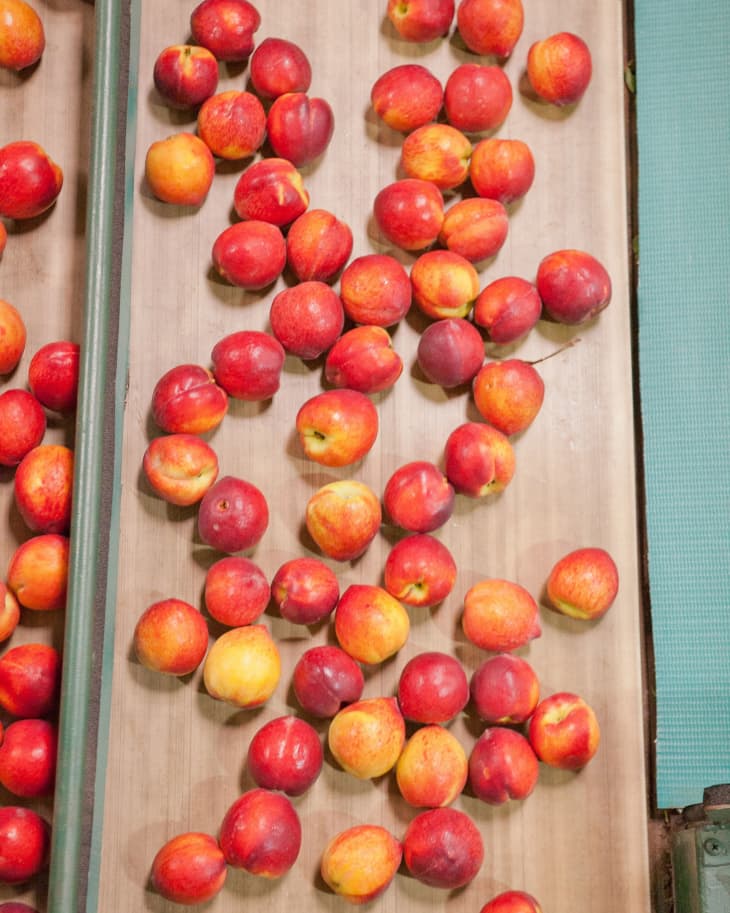How Peaches Are Packed for Shipping
Who: Lane Southern Orchards
What: Georgia peaches
Where: Fort Valley, GA
Gleaming white rocking chairs lined up across a wide porch send a welcoming signal to visitors of Lane Southern Orchards in Fort Valley, Georgia. And there are a lot of them; Lane hosted more than 350,000 people last year. They come for the farm-fresh peaches – and the variety of incredible edibles made using them – and to get a behind-the-scenes look at the 100-year-old company’s operations.
The front part of Lane’s building is a retail store and restaurant featuring peach ice cream (they go through 300 gallons a week), peach bread (20,000 loaves each year), peach cobblers (more than 300 on summer weekends), peach fritters, and peach fried pies, all churned and baked onsite. Other products using Lane peaches are available as well, like sauces and jams, but they are made at another facility.
But in back, thousands of pounds of just-picked peaches are being washed, sorted, and boxed, and guests can watch it all from an elevated platform.
How Fresh Peaches Are Packed for Shipping
Trucks bring bins packed with peaches to large rear doors, where they are emptied into 36-degree water to halt ripening. They are transferred from the water to a conveyor belt, which moves approximately 70,000 pounds of peaches each hour. They run through water again to wash them before they get to the graders, workers who trust their eyes and hands to “grade” each and every peach.
“They look them over, feel them,” says David Lane. Based on what they detect, they assign the peaches a number. “Some are already rotting or cut up and leaking; those just go straight into the lane of water flowing below them, which carries those peaches to the trash.” The others are ranked No. 1, No. 2, or No. 3.
“The No. 3 peach is a good peach, but almost too ripe, so it won’t make it anywhere. It has to be used probably within a day,” says Lane. These peaches are placed on a separate conveyor belt that takes them to another group, who choose the very best to go to Lane’s store up front. “The ones that don’t make that cut go to a local food bank, or unfortunately, the trash.”
A No. 2 peach is a great peach, but it has a scratch or some other defect that mars its appearance.
A No. 1 peach is just that: “It is the A+, number-one winner — a perfect peach,” says Lane.
The peaches that passed muster are run along another conveyer line, divided into rows, where a computerized optical sizer uses 40 cameras (five per row) to determine the peaches’ size. According to Lane, “It’s pretty amazing how accurate it is, and after sizing, it is programmed to drop the 2.5-inch peaches on one conveyer line and the 2.75-inch peaches on another, and so on.”
A scale under each box calculates its weight as it is filled and lets the packer know when to stop adding fruit. When the boxes are filled, they’re sent on their way, headed to stores scattered all around the country, from the Midwest and Texas to the Northeast and down to Florida. Soon, they’ll be on a stand or lining a rack, waiting to be chosen and taken to someone’s home. When they get there, they probably won’t last long. Sweet treats like Georgia peaches always get eaten first.
Quick Questions for David Lane
1. How many peaches are processed per day?
The first conveyor belt, from wash to grading, moves approximately 70,000 pounds of peaches each hour.
2. Are peaches graded by machine or by hand?
Both. Workers grade the fruit by sight and touch before a computerized optical sizer measures each peach.
3. Why are peaches packaged by hand?
We tried using automated packers, but they bruised too many peaches, so we went back to hand-packaging.
4. What are the grades used?
No. 3 peaches, being almost too ripe, go to the Lane store or sometimes to a food bank. No. 2 peaches only have a visual defect and are sold as a No. 2, and No. 1 peaches are perfect.
5. How many people visit Lane each year?
In 2014 more than 350,000 visitors came to see us — the majority in the busy summer months — and enjoyed over 20,000 loves of peach bread and helped consume an average of 300 gallons of ice cream per week.
Thanks, David!
